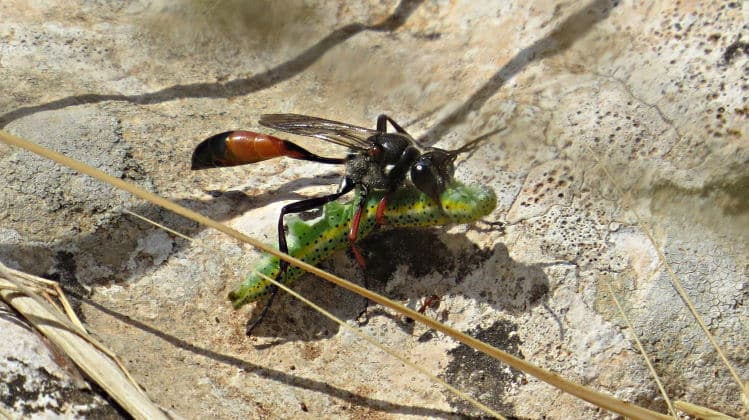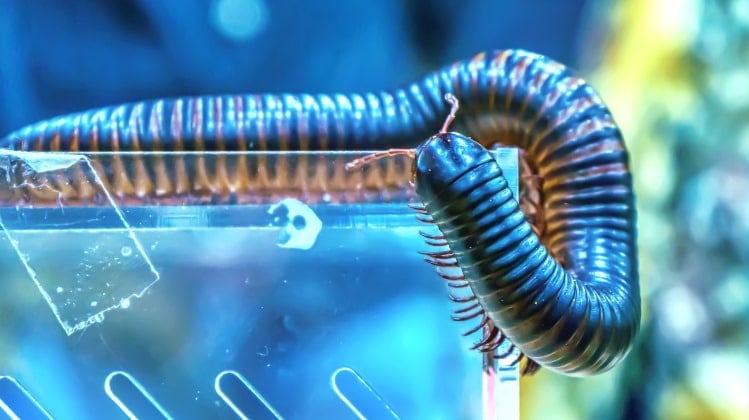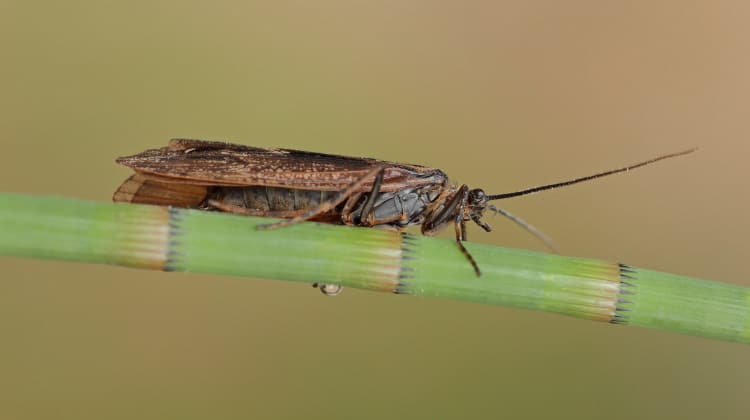Do Carpet Beetles Travel With You? On Humans, Clothing…
Do Carpet Beetles Travel With You?
[modified-date]
[social-share]
Long story short, yes, carpet beetles can and will travel with you.
Carpet beetles are capable of breeding and developing on different clothing fabrics without you knowing and you’ll then transport them around with you.
But what exactly are they? Do carpet beetles travel with you? Where have they come from and how can you get rid of them?
Inhabiting the clothes you wear or the luggage you transport around with you, adult carpet beetles don’t just destroy the carpets on your floor.
Attracted to any natural material containing keratin, adult carpet beetles will attach to, travel with, and eat away at anything they can find.
They cause so much damage that their infestation is often mistakenly identified as clothes moths.
What Are They?
Carpet beetles are small invertebrates that invade your home and eat away at your carpet, furniture, and clothing.
Attracted to natural fibers, carpet beetle larvae find comfort in eating away at fabrics such as wool, linen, and silk. However, if those fabrics are not available to them they have been known to eat animal hairs or left out dog food in desperation.
Adult carpet beetles, however, going against their name, would usually feed on plants, flowers, and sweet pollen. However, if they are born indoors they lay their eggs in dark, humid places and tend to settle in thick carpets and on the backs of furniture.
Generally laying up to and often over 100 eggs at a time and taking around two weeks to hatch, a small carpet beetle infestation quickly turns into a larger issue.
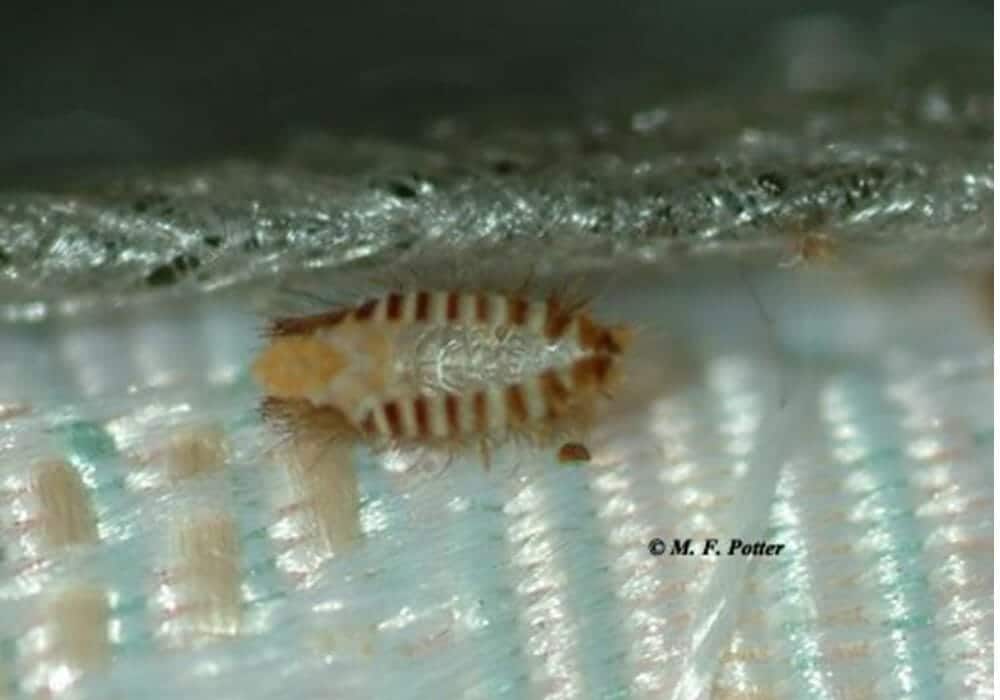
What Do They Look Like?
Around 2-5 mm in length, carpet beetles are small oval-shaped little beetles.
When they are first born, larvae have small banded bodies covered in erect brown bristles. Due to this, they are often mistaken for small hairy caterpillars.
After a few months, the larvae then develop into adults with round body shapes accompanied by two short antennae on their heads and three pairs of scuttling legs. There are many types of carpet beetles but the majority are covered in orange, yellow, and white colorings.
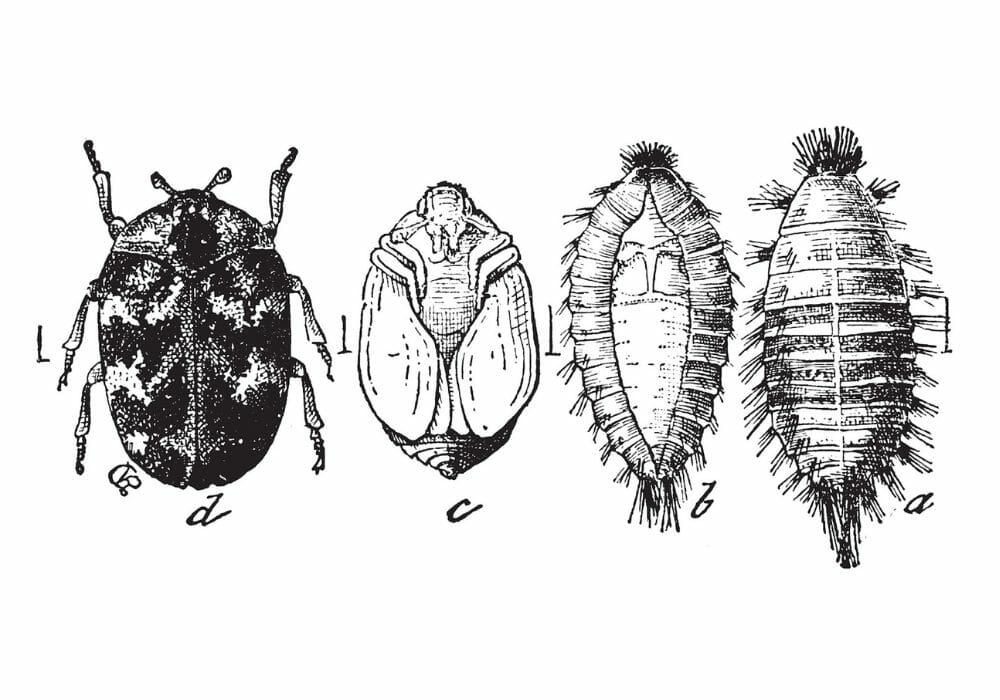
Did you Know?
Carpet beetles won’t bite people and cause any harm as they don’t have mandibles big enough or venom to cause any pain or damage.
The Common Carpet Beetle
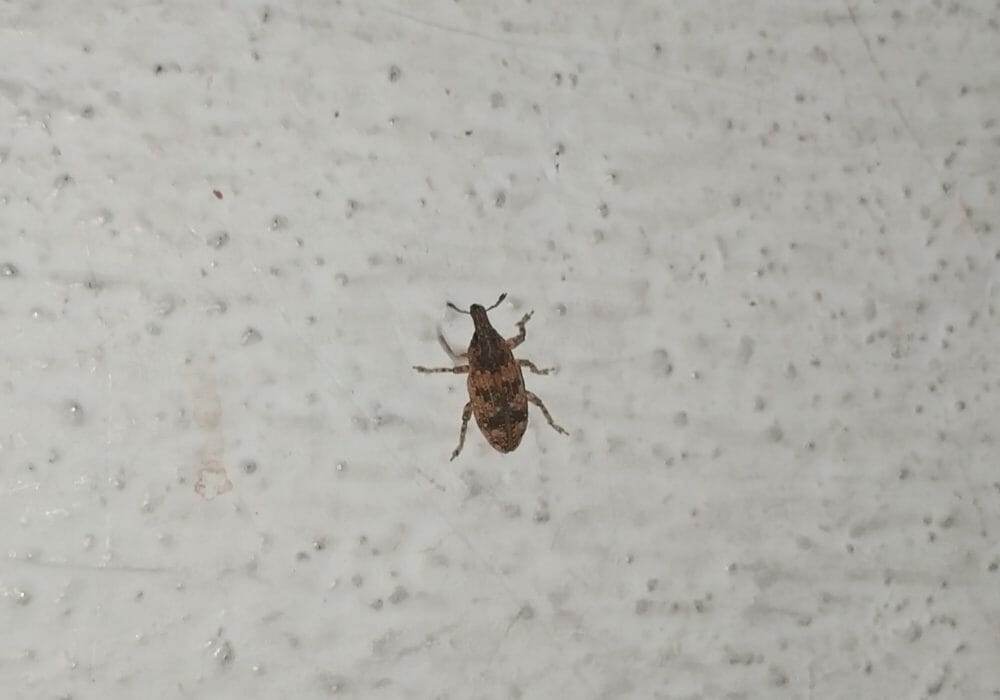
This subspecies of carpet beetle was named after its identification in a lot of American homes as they were formerly covered in carpets.
Originally a pest in Europe, the common carpet beetle is said to have been introduced to America in 1874. They supposedly entered people’s houses by latching onto their clothing.
The Black Carpet Beetle
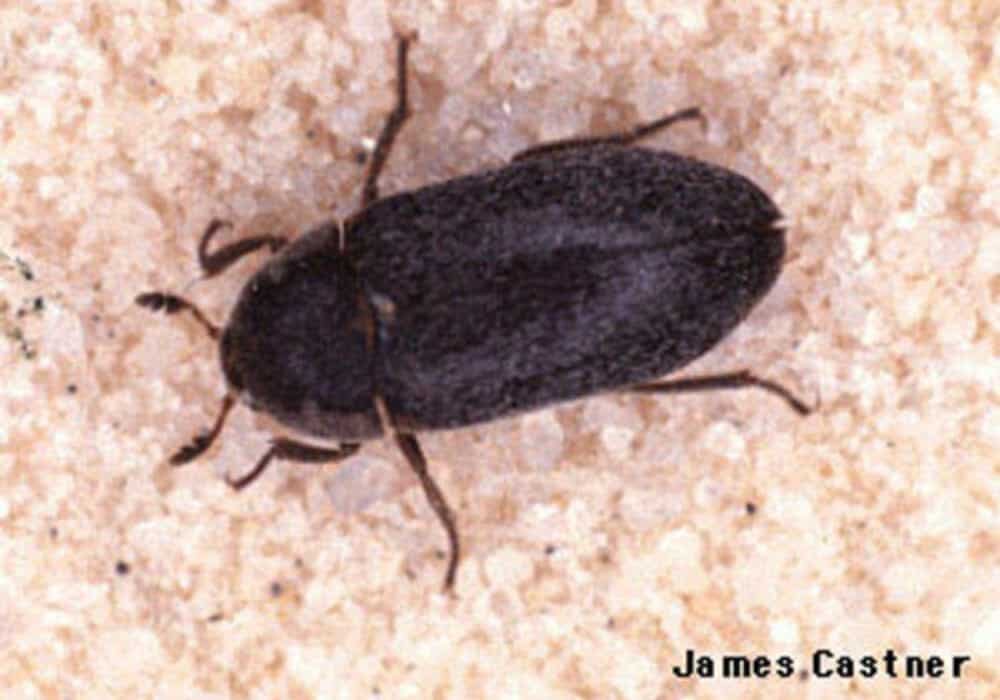
As larvae, the beetles are golden brown and reddish and then develop into their famed all-black color.
Widespread across Europe, Asia, and the United States, the black carpet beetle is the most injurious subspecies feeding on a variety of fabrics such as wool, feathers, fur, and silk.
They have also been spotted in household larders feeding on cereals and grains.
A female will lay white fragile eggs on tucked-away fabrics and in cracks in the floor and will only reproduce once in her lifetime. After laying the eggs, the parent insect’s life will end at a grand old age of 35 days maximum.
The Varied Carpet Beetle
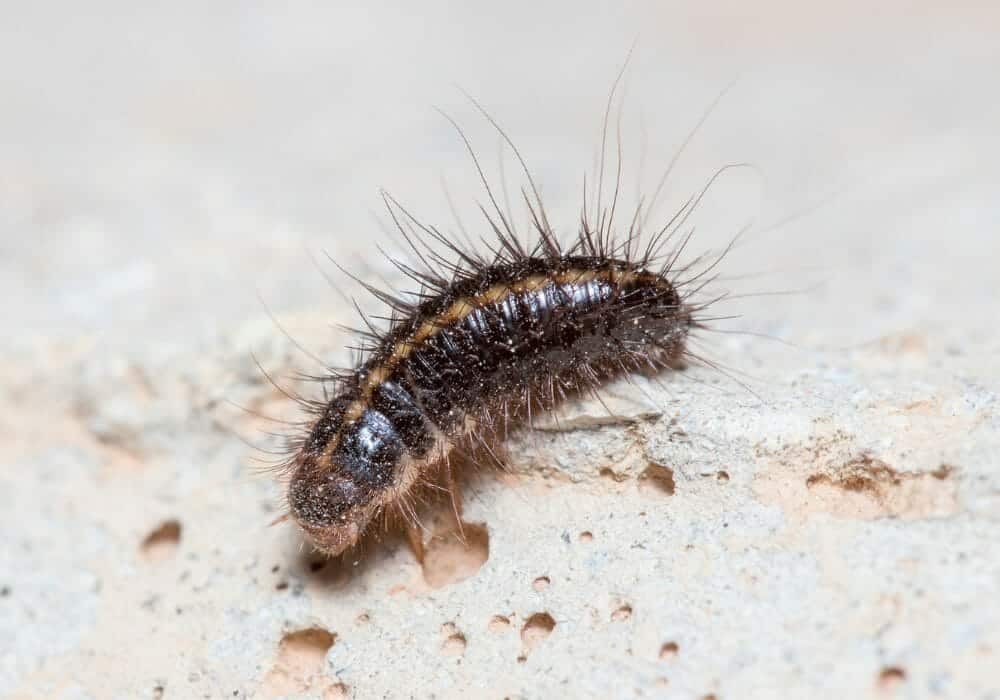
Similar in size to the common carpet beetle but perhaps slightly smaller. The varied carpet beetle gets its name from its variety of markings. White, brown, yellow, and orange arrangements of color cover its abdomen with an underside oddly covered in arranged white scales.
Like the previously mentioned subspecies, these beetles are transported into people’s homes. They lay their larvae in various locations throughout. Varied carpet beetles develop into pests feeding on natural materials in the home.
Once they have done so and the larvae become adults, new larvae are laid and the adults leave to feed on plants, flowers, and pollen outside.
The Furniture Carpet Beetle
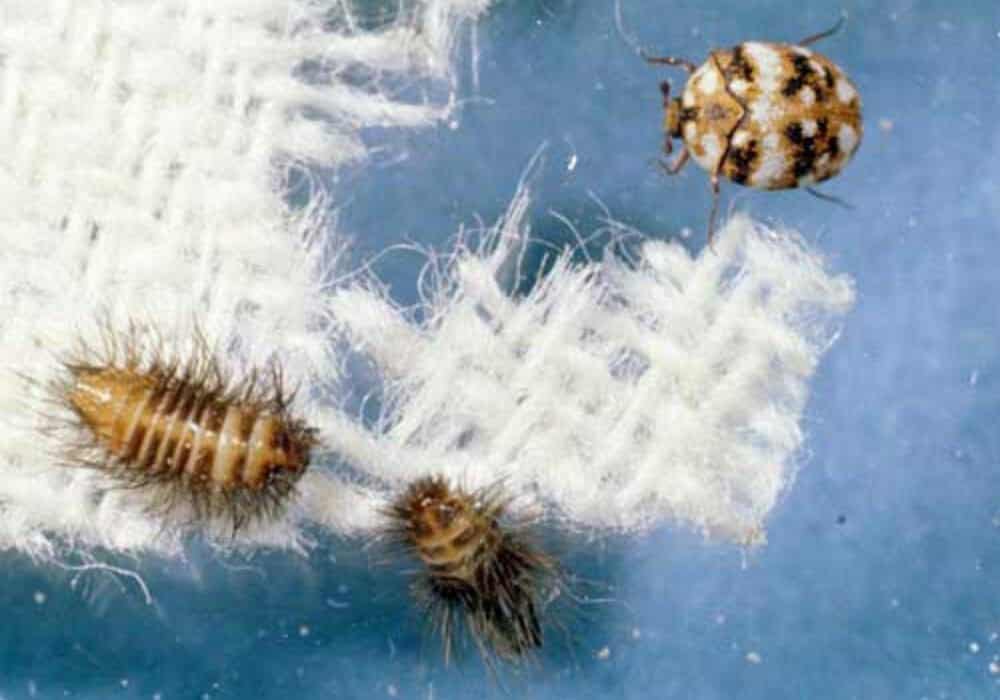
Known to eat through and create holes in both leather and linen furniture coverings, this subspecies of carpet beetle is a particular pest.
Fortunately, the species isn’t known to reproduce a lot so they can be controlled quite easily. A female can lay up to 30 eggs in a day but the larvae are often destroyed by people brushing along furniture and crushing them.
However, burrowing into the furniture’s inner linings makes these carpet beetles particularly transportable especially when larvae have just hatched.
Where Do They Come From?
No, you are not a dirty person if your carpet, furniture, or house becomes infested with carpet beetles. Unfortunately, it’s just bad luck.
Although carpet beetles do like to live outside and consume flowers and plants, they will happily hitch a ride into your home on the flowers you buy, your pets, or yourselves.
Over time, the beetles find their way around your house or fall to the floor and are enticed to your carpets or furniture for safety and food.
When the sun sets, carpet beetles undergo phototaxis and are attracted to the artificial light that a house emits. They are therefore attracted to cracks and gaps around window sills, vents, or chimneys and infest homes.
4 Signs Of Infestation
People usually don’t realize they have a carpet beetle infestation until the damage to furniture and clothes is noticed. However, there are a few warning signs people should know to detect this fabric pest sooner.
Skins On The Floor
To mature into an adult, carpet beetle larvae shed their skin multiple times while developing.
Described similarly to the skin of a sunflower seed or nut with a light brown and orange tint, shed skins can be found anywhere in your infested home.
Droppings
As with any other animal living in your home without you knowing, you’ll recognize their presence when you notice unusual drops around your home.
Carpet beetle droppings are the size of table salt grains and are described as black or brown.
They are known to poo close to where they feed so you can usually find the beetles near their droppings.
Damaged Furniture Or Clothing
Although their usual diet consists of flowers, plants, and nectar in wild spaces or people’s gardens, carpet beetles are also fond of eating natural fibers such as wool, linen, and leather.
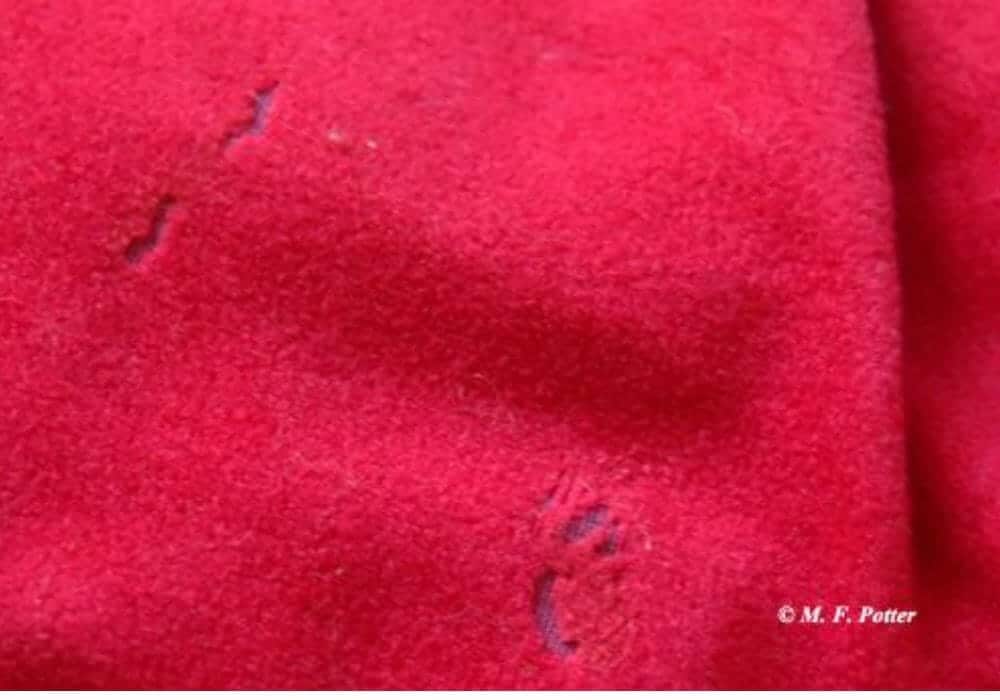
However, they tend to burrow inside materials. If droppings or skins are to be found it may be worth looking at the inner lining of your sofa, carpet, or other furniture as they will be hidden from sight.
Eye Irritation
If carpet beetles infest a home for a long period, people have been known to suffer from eye irritations and breathing difficulties. This has subsequently been diagnosed as carpet beetle dermatitis. The hairs and hemolymph, a fluid similar to blood in invertebrates, can cause allergic reactions.
Conclusion
Capable of infesting anyone’s home, carpet beetles will attach to people’s clothing, animals, or furniture and disrupt your belongings.
People must be aware of the signs of infestation to catch the beetles early on and not suffer long-term damage to their homes and their health.
Catching an infestation early will also prevent them from traveling with you without you knowing and entering other people’s homes.
Reference List
- Carpet beetles and their control (No. 1346)’. Back, E.A., 1923. US Government Printing Office.
- Carpet beetles’. Cranshaw, W., 1996. Colorado State University Cooperative Extension Service.
- Clothes Moths and Carpet Beetles’.Shepard, H.H., 1940.
- (Z)-5-and (E)-5-Undecenoic acid: Identification of the sex pheromone of the varied carpet beetle, Anthrenus verbasci L.(Coleoptera: Dermestidae)’. KUWAHARA, Y. and NAKAMURA, S., 1985. Applied Entomology and Zoology.
- Controlling clothes moths and carpet beetles in the home. Stone, R.E., 1943. University of Missouri, Agricultural Experiment Station.
- LIFE CYCLE OF MUSEUM PEST ANTHRENUS FLAVIPES (LEC.)(COLEOPTERA: DERMISTIDAE)’. Kumar, S., Khamashon, L., Pandey, P., Chaudhary, R. and Joshi, P.C., 2013. American Journal of Research Communication.
- Carpet Beetles.’ University of Kentucky.
- Carpet beetle dermatitis’. Ahmed, A.R., Moy, R., Barr, A.R. and Price, Z., 1981. Journal of the American Academy of Dermatology.
- Dermestid Beetles (Carpet Beetles)’. Cranshaw, W.S. Doctoral dissertation, Colorado State University. Library.
- Dermestid dermatitis in a 2‐year‐old girl: case report and review of the literature. Hoverson, K., Wohltmann, W.E., Pollack, R.J. and Schissel, D.J., 2015. Pediatric Dermatology.
- Effect of adult diet on the longevity, fecundity, oviposition period and phototaxis in the black carpet beetle, Attagenus megatoma (F.)’. Kiritani, K. and Kawahara, S., 1963.
Founder of Re-Educating Earthlings environmental education platform | Children’s Author | Freelance environmental writer | ‘No one can do everything, but, someone can do something’. LinkedIn Profile.
Disclaimer
Earthlife.net does not provide medical advice. We do our best to help users understand the science behind living beings; however, the content in the articles and on the website is not intended to substitute for consultation with a qualified expert. By interacting with the website and/or our email service, you agree to our disclaimer. Remember that you must consult a specialist before using any of the products or advice on the web.

